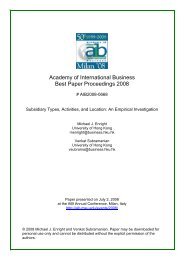AIB 2012 Conference Proceedings - Academy of International ...
AIB 2012 Conference Proceedings - Academy of International ...
AIB 2012 Conference Proceedings - Academy of International ...
You also want an ePaper? Increase the reach of your titles
YUMPU automatically turns print PDFs into web optimized ePapers that Google loves.
MONDAY<br />
expatriate staffing strategy <strong>of</strong> reverse-innovating MNEs. We tested our hypotheses against a sample <strong>of</strong> 514<br />
subsidiaries established in 15 emerging markets during the period between 1996-2006. The results support our<br />
development <strong>of</strong> an integrated TCE-RBV conceptualization <strong>of</strong> the impact <strong>of</strong> normative institutions on the<br />
strategy, structure and performance <strong>of</strong> foreign-investing MNEs. Within this framework, our results suggest that<br />
as governmental normative distance increases, reverse-innovating MNEs will prefer to employ more expatriates<br />
and to enter emerging markets via a wholly-owned governance structure. Conversely, under conditions <strong>of</strong><br />
heightened technological normative distance, these same MNEs will choose to enter through joint venture<br />
partnerships. To examine the efficacy <strong>of</strong> these risk-reduction strategies, we investigated the performance<br />
implications associated with these strategic endeavors. Reverse-innovating MNEs' preference for full ownership<br />
was found to predict enhanced financial performance. (For more information, please contact: Michael Sartor,<br />
University <strong>of</strong> Western Ontario, Canada: msartor.phd@ivey.ca)<br />
The Economic Impacts <strong>of</strong> Technological Capability, FDI and R&D in Emerging Economies<br />
Hyun Shin, Long Island University<br />
Steven Chang, Long Island University<br />
In this paper, we investigate the dynamic, interdependent relations among technological capability (embodied<br />
vs. disembodied technology position), FDI (inward vs. outward FDI), R&D, and a nation's economic progress<br />
(GDP). We choose four emerging countries in two clusters: 1) Brazil and Mexico (Catching-up) and 2) Korea and<br />
Taiwan (Pre-frontier). We use Vector Autoregressive (VAR) modeling to analyze quarterly time-series data<br />
(1998:1Q-2007:4Q) between two important global economic events, i.e., the Asian Financial Crisis <strong>of</strong> 1997 and<br />
the Subprime Mortgage Crisis <strong>of</strong> 2008. We find that 1) technological capability has a positive long-run impact on<br />
GDP <strong>of</strong> Korea and Taiwan; and 2) enhanced embodied position helps Mexico and Brazil attract more inward FDI<br />
while improved disembodied position facilitates Taiwan and Korea to increase outward FDI over time. In<br />
addition, we observe that the relationship among technological capability, FDI, and R&D varies across countries.<br />
These findings provide insightful policy implications for emerging economies at different development stages,<br />
helping them compete successfully in a globalized economy. (For more information, please contact: Hyun Shin,<br />
Long Island University, USA: hyun.shin@liu.edu)<br />
Export Intensity, Domestic Market Competition, and Product Innovation in an Emerging Economy<br />
Zhenzhen Xie, Hong Kong University <strong>of</strong> Science and Technology<br />
Jiatao Li, Hong Kong University <strong>of</strong> Science and Technology<br />
Recent empirical studies have consistently found a positive relationship between firm-level export and product<br />
innovation, attributing this as "learning by exporting". We argue that in a large emerging economy such as<br />
China, this relationship could be inverted-U shaped. Exporters in emerging economies are usually technology<br />
leaders in their domestic market, but technology laggards in international markets. When the export intensity is<br />
low, the exporters pay attention to the domestic market and tend to make product innovation by combining<br />
their domestic market knowledge with superior technological capabilities gained from exporting. When export<br />
intensity exceeds a threshold, the exporters may shift their focus to overseas markets, where their competitive<br />
advantage might lie in efficient and quality manufacturing rather than in superior technological or market<br />
knowledge. This may prevent highly intensive exporters from making product innovation. When domestic<br />
competition is high, less intensive exporters are more likely to make full use <strong>of</strong> the knowledge they gain through<br />
exporting and make product innovations to compete domestically. Meanwhile, intense domestic competition<br />
might push exporters to focus more on efficient and quality production and abandon product innovation. An<br />
analysis on 6,197 manufacturers in China's automobile industry during 2005-2007 supports the above<br />
argument. (For more information, please contact: Zhenzhen Xie, Hong Kong University <strong>of</strong> Science and<br />
Technology, Hong Kong, SAR-PRC: xiezz@ust.hk)<br />
<strong>AIB</strong> <strong>2012</strong> <strong>Conference</strong> <strong>Proceedings</strong><br />
Page 129

















